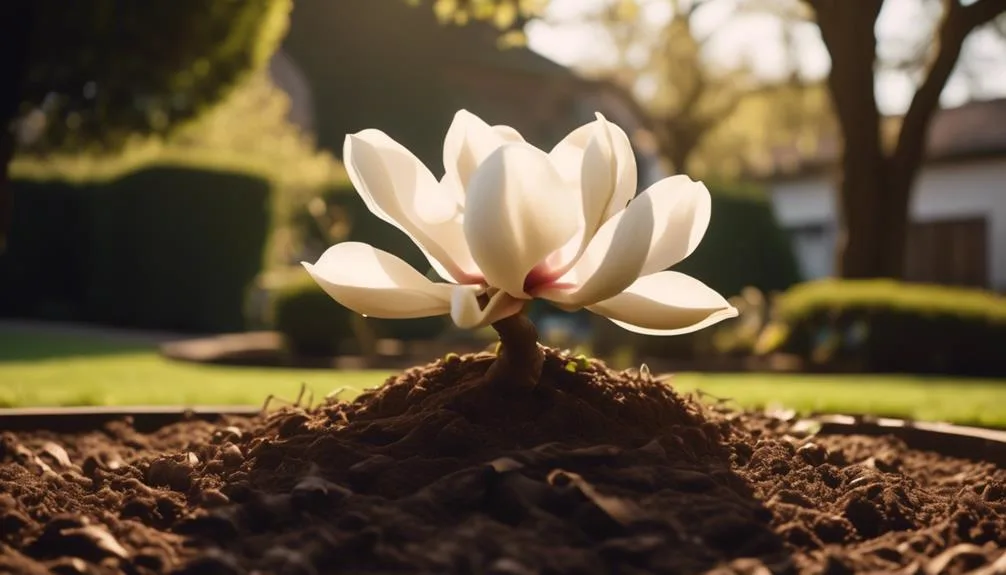Choosing the right spot to plant magnolia trees is crucial for their growth. Factors like sunlight and soil composition greatly influence their health and vibrancy. Understanding these elements is key to ensuring your magnolia thrives.
Let's explore the secrets to unlocking the full potential of these beautiful trees.
Sunlight Requirements
To ensure optimal growth for your magnolia trees, it's essential to provide them with ample sunlight throughout the day. Magnolia trees thrive in full sunlight, requiring at least six hours of direct sunlight daily. This ensures proper photosynthesis and robust growth.
When choosing a location for your magnolia tree, select a spot that receives plenty of sunlight and has well-draining soil. Additionally, consider the tree's mature size to avoid shading from nearby structures or larger trees.
During winter, protect your magnolia trees from frost and freezing temperatures, as they can be vulnerable to cold damage. Implement pruning techniques to maintain a healthy shape and structure, and consider applying a balanced fertilizer in spring to support overall tree maintenance and growth.
Following these practices will help your magnolia trees flourish.
Soil Conditions
For optimal growth of your magnolia trees, ensure the soil conditions are well-draining and slightly acidic, with a pH level between 5.0 and 6.5. Good drainage is crucial as magnolia trees prefer moist but not waterlogged soil. Sandy or loamy soils are ideal for their drainage requirements. Additionally, these soils offer good moisture retention, which is essential for the trees' healthy development.
When it comes to pH levels, slightly acidic soil is best for magnolia trees, as it allows for the proper nutrient content to be available to the roots. This type of soil promotes the uptake of essential nutrients like iron and magnesium.
Watering Needs
Ensure your magnolia trees receive consistent and thorough watering to support their healthy growth and development. Magnolia trees have shallow roots that spread wide, so it's crucial to water them deeply.
Watering frequency is key; young trees may need watering twice a week in the growing season, while mature trees may only need it once a week. Understanding the root depth is essential to ensure water reaches the entire root system.
Magnolias are generally drought-tolerant once established, but adequate moisture is vital during dry spells. Consider using a slow irrigation technique such as a drip system to deliver water directly to the roots, minimizing evaporation.
Keep in mind that overwatering can lead to root rot, so it's important to find the right balance.
Space and Location
Considering the shallow root system and watering needs of magnolia trees, selecting an appropriate space and location is crucial for their optimal growth and development. When planning your garden design, it's important to consider the mature size of the magnolia tree.
These trees thrive in locations with well-drained, slightly acidic soil and full to partial sun exposure. Proper tree spacing is essential to ensure that each magnolia has enough room to spread its branches without overcrowding. Adequate spacing also allows for proper air circulation, which can help prevent diseases and promote healthy growth.
When choosing a location, keep in mind that proximity to buildings or other large trees may cast too much shade or obstruct the roots. By carefully considering these factors, you can create an ideal environment for your magnolia trees to flourish.
Climate Considerations
When selecting a location for planting magnolia trees, it's important to take into account the climate of your region and choose a spot that provides the ideal conditions for their growth and blooming. Consider the following climate factors for optimal growth:
- Temperature Range: Magnolias thrive in regions with moderate temperatures, typically between 15°C to 25°C, and require a period of winter chill for flowering.
- Precipitation: Magnolias prefer well-drained soil and moderate rainfall, around 40-80 inches annually, to support healthy growth.
- Wind Tolerance: Choose a location with some protection from strong winds, as excessive wind can damage the delicate blossoms and foliage.
- Humidity Levels: Magnolias generally prefer moderate to high humidity levels, making coastal areas or regions with consistent humidity favorable for their growth.
Considering these climate factors when selecting a location will ensure that your magnolia trees thrive and produce beautiful blooms year after year.
Conclusion
In choosing a sunny spot with well-drained soil and considering watering needs and climate, your magnolia tree will thrive and grace your landscape for years to come.
Happy planting!
Mark Hoffman is a dedicated arborist and tree care specialist with over a decade of experience. His love for trees began when he visited Yosemite National Park as a teenager and was awestruck by the giant sequoias. Mark pursued his passion by studying forestry at Michigan Technological University, where he earned a Bachelor of Science degree.
Since then, he has worked tirelessly in the field of arboriculture, helping to preserve and protect trees in his community. His expertise and dedication have made him a respected leader in the industry and a valuable resource for anyone seeking advice on tree care.
